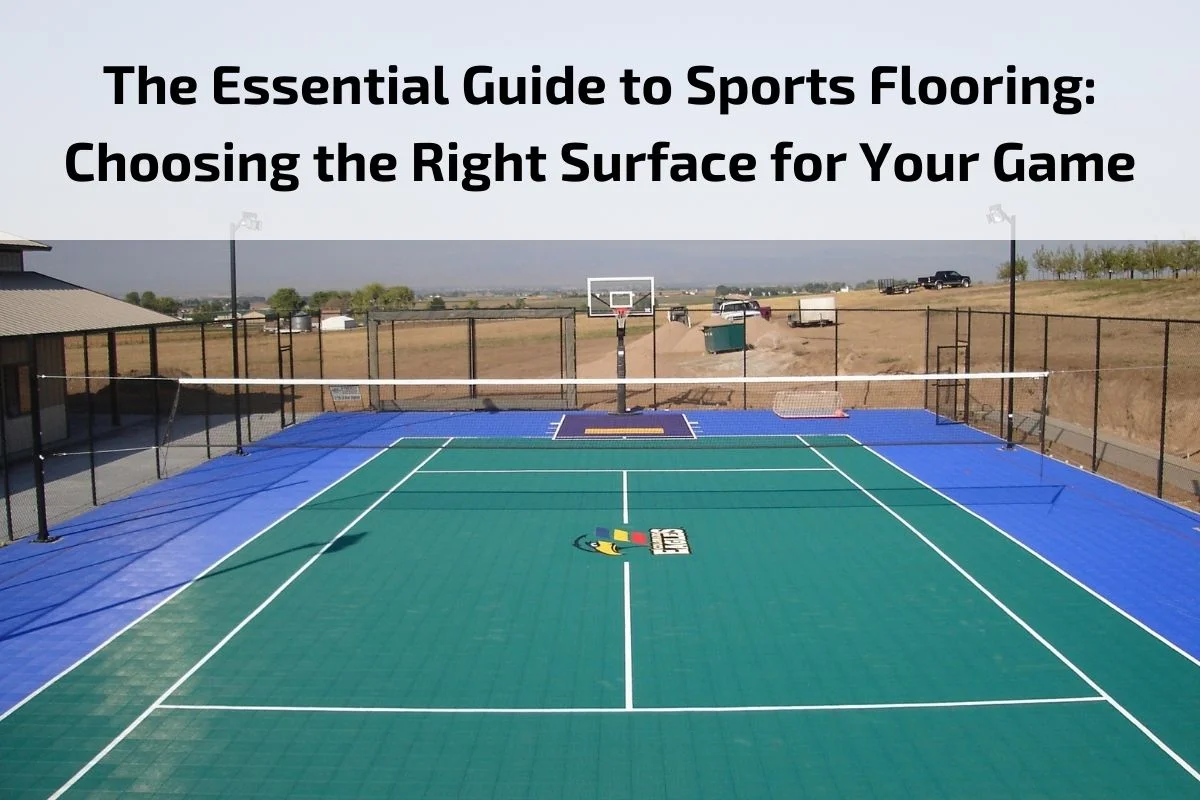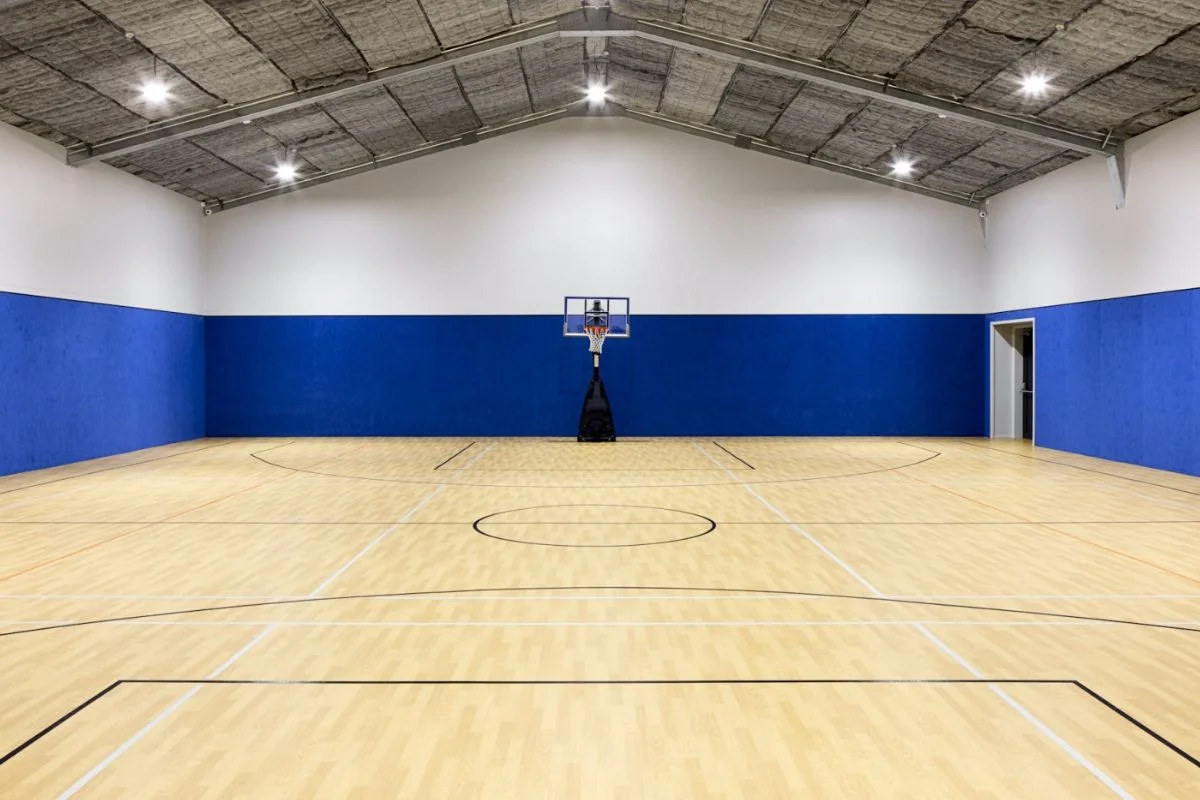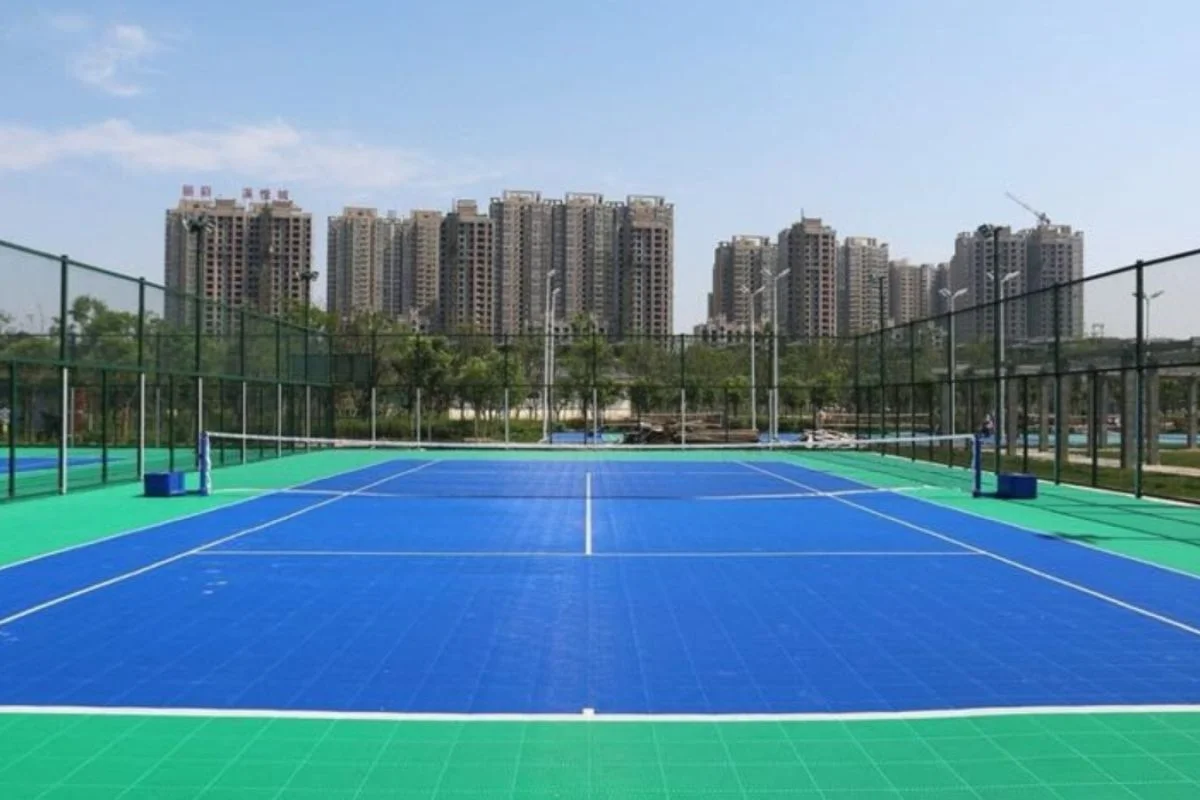Blog
 In the dynamic world of sports, the surface beneath your feet holds more significance than you might imagine. Whether you’re sprinting down a basketball court, executing a perfect serve on a tennis court, or grappling in a martial arts studio, the quality and composition of the flooring impact your performance, safety, and overall experience.
Welcome to “The Essential Guide to Sports Flooring: Choosing the Right Surface for Your Game.” In this comprehensive exploration, we delve into the intricacies of sports flooring, uncovering the key factors that influence selection, installation, and maintenance. From traditional hardwood courts to state-of-the-art synthetic materials, the choices available to athletes, coaches, and facility managers are vast and diverse.
Join us as we navigate through the science, technology, and innovation driving the evolution of sports flooring. Whether you’re a professional athlete, a recreational enthusiast, or a facility manager seeking the best flooring solution, this guide aims to equip you with the knowledge and insights necessary to make informed decisions that optimize performance, enhance safety, and elevate the sporting experience.
In the dynamic world of sports, the surface beneath your feet holds more significance than you might imagine. Whether you’re sprinting down a basketball court, executing a perfect serve on a tennis court, or grappling in a martial arts studio, the quality and composition of the flooring impact your performance, safety, and overall experience.
Welcome to “The Essential Guide to Sports Flooring: Choosing the Right Surface for Your Game.” In this comprehensive exploration, we delve into the intricacies of sports flooring, uncovering the key factors that influence selection, installation, and maintenance. From traditional hardwood courts to state-of-the-art synthetic materials, the choices available to athletes, coaches, and facility managers are vast and diverse.
Join us as we navigate through the science, technology, and innovation driving the evolution of sports flooring. Whether you’re a professional athlete, a recreational enthusiast, or a facility manager seeking the best flooring solution, this guide aims to equip you with the knowledge and insights necessary to make informed decisions that optimize performance, enhance safety, and elevate the sporting experience.
Importance of sports flooring in athletic performance and safety
The importance of sports flooring in athletic performance and safety cannot be overstated. From professional arenas to community recreation centers, the surface on which athletes compete and train plays a crucial role in their success and well-being.
Performance Enhancement:
- Surface Consistency: A high-quality sports floor offers consistent traction and bounce, enabling athletes to move confidently and execute their skills with precision.
- Shock Absorption: Properly cushioned flooring absorbs impact forces, reducing the strain on athletes’ joints and muscles during high-intensity movements like running, jumping, and landing.
- Ball Response: Sports flooring influences the behavior of balls and equipment, affecting the speed, bounce, and trajectory of play in sports like basketball, volleyball, and soccer.
- Impact Reduction: Sports flooring with adequate shock absorption helps minimize the risk of impact-related injuries such as stress fractures, shin splints, and joint pain.
- Slip Resistance: A non-slip surface prevents accidental slips and falls, especially in fast-paced and high-contact sports, reducing the likelihood of sprains, strains, and head injuries.
- Stability and Support: The right flooring provides a stable foundation for athletes, enhancing balance, agility, and proprioception while reducing the risk of ankle twists and falls.
- Cleanliness: Sports flooring designed for easy cleaning and maintenance promotes a hygienic environment, minimizing the spread of bacteria, viruses, and fungi commonly associated with sweat and bodily fluids.
- Durability: Durable sports flooring withstands heavy foot traffic, equipment impact, and environmental factors, ensuring long-term performance and safety for athletes and facility users.
- Resilience: Resilient flooring materials maintain their structural integrity over time, resisting wear, indentation, and deformation even under rigorous training and competition conditions.
- Confidence and Comfort: Athletes perform better when they feel confident in their surroundings. A well-maintained and supportive sports floor fosters a sense of comfort, security, and trust, allowing athletes to focus on their game without distraction or apprehension.
- Motivation and Pride: State-of-the-art sports flooring reflects a commitment to excellence and professionalism, inspiring athletes to strive for greatness and take pride in their training and achievements.
Understanding Different Types of Sports Flooring
Understanding the different types of sports flooring is essential for selecting the most suitable surface for specific athletic activities. From traditional hardwood courts to advanced synthetic materials, each type of flooring offers unique characteristics, advantages, and considerations. Here’s an overview of some common types of sports flooring:
Hardwood Flooring:
- Description: Hardwood flooring, typically made of maple or oak, is a classic choice for indoor sports facilities such as basketball courts and dance studios.
- Advantages: Provides excellent ball bounce and traction, ideal for sports requiring quick movements and precise footwork. Offers a professional appearance and durability with proper maintenance.
- Considerations: Vulnerable to moisture and temperature fluctuations, requiring climate-controlled environments. Regular refinishing is necessary to maintain optimal performance and appearance.
- Description: Synthetic sports flooring encompasses a variety of materials such as polyurethane, PVC, and rubber. It is commonly used in multipurpose gyms, indoor tracks, and aerobic studios.
- Advantages: Offers versatility, shock absorption, and uniformity of surface, suitable for a wide range of sports and activities. Available in different thicknesses and densities to meet specific performance requirements.
- Considerations: Quality and performance vary based on material composition and installation method. Some synthetic materials may emit volatile organic compounds (VOCs) and require proper ventilation.
- Description: Rubber flooring, made from recycled tires or synthetic rubber compounds, is popular for indoor and outdoor sports courts, weight rooms, and fitness centers.
- Advantages: Provides excellent shock absorption, slip resistance, and sound insulation, reducing noise and impact during intense workouts. Durable, low-maintenance, and resistant to moisture and stains.
- Considerations: Surface texture and thickness impact traction and performance. Certain rubber compounds may degrade over time with exposure to UV rays and harsh weather conditions.
- Description: Artificial turf consists of synthetic fibers designed to mimic natural grass, commonly used in outdoor sports fields for soccer, football, and baseball.
- Advantages: Offers consistent playing surface, durability, and all-weather usability, reducing maintenance costs and water consumption compared to natural grass. Provides cushioning and support for athletes during high-impact activities.
- Considerations: Requires proper drainage and infill materials to prevent compaction and maintain optimal performance. Surface heat retention can be a concern in hot climates.
- Description: Modular flooring comprises interlocking tiles or panels made of various materials such as plastic, wood, or composite materials. It is used for portable courts, temporary event spaces, and modular fitness areas.
- Advantages: Easy to install, reconfigure, and transport, offering flexibility for temporary and permanent sports surfaces. Provides shock absorption, stability, and customization options for different sports and activities.
- Considerations: Quality and durability vary based on material composition and locking mechanism. May require periodic maintenance to ensure proper interlocking and stability.
Factors to Consider When Choosing Sports Flooring
When choosing sports flooring, several factors must be carefully considered to ensure optimal performance, safety, and longevity. Here are key factors to keep in mind:
Performance Requirements:
- Impact Absorption: Evaluate the flooring’s ability to absorb impact forces, reducing the risk of injury during high-intensity activities.
- Ball Bounce and Response: Consider the surface’s elasticity and friction properties to ensure consistent ball bounce and control in sports like basketball, volleyball, and tennis.
- Surface Traction: Assess the level of grip and slip resistance to prevent accidental falls and enhance athlete stability and maneuverability.
- Shock Absorption: Choose flooring with adequate shock absorption properties to minimize stress on joints and muscles, reducing the risk of impact-related injuries.
- Slip Resistance: Prioritize flooring materials with anti-slip surfaces to provide traction and stability, especially in wet or high-traffic areas prone to slips and falls.
- Impact Protection: Opt for flooring systems that offer cushioning and resilience to cushion falls and mitigate the risk of head injuries and fractures.
- Lifespan: Select flooring materials that are durable and resistant to wear, tear, and deformation, ensuring long-term performance and cost-effectiveness.
- Maintenance Requirements: Consider the ease of cleaning, repair, and maintenance to sustain the flooring’s appearance and functionality over time.
- Resistance to Moisture and Chemicals: Choose flooring solutions that withstand moisture, humidity, and exposure to cleaning agents and chemicals without compromising performance or safety.
- Initial Investment: Evaluate the upfront costs of materials, installation, and additional accessories against the long-term benefits and performance of the flooring system.
- Total Cost of Ownership: Factor in maintenance, repair, and replacement costs over the lifespan of the flooring to determine the overall cost-effectiveness and return on investment.
- Material Composition: Consider eco-friendly and sustainable flooring options made from recycled materials or renewable resources, minimizing environmental footprint and promoting responsible stewardship.
- Energy Efficiency: Explore flooring solutions that contribute to energy conservation, thermal insulation, and indoor air quality improvements within sports facilities and venues.
- Certifications and Testing: Ensure that the chosen flooring meets industry standards, certifications, and safety regulations established by organizations such as ASTM International, EN standards, and regulatory bodies governing sports facilities and venues.
- Accessibility: Address accessibility requirements for individuals with disabilities, including wheelchair access, tactile indicators, and color contrast for visually impaired users.
Benefits of Sports Flooring
Sports flooring offers a multitude of benefits that contribute to the overall performance, safety, and enjoyment of athletes, trainers, and participants. Here are some key benefits of sports flooring:
Enhanced Performance: Sports flooring is designed to provide optimal traction, shock absorption, and ball response, allowing athletes to perform at their best. The consistent surface ensures reliable footing, enabling athletes to execute movements with precision and confidence.
Injury Prevention: High-quality sports flooring helps mitigate the risk of injuries by cushioning impact forces and reducing strain on joints, ligaments, and muscles. Shock-absorbing properties minimize the impact of falls and collisions, decreasing the likelihood of sprains, strains, and fractures.
Safety and Protection: Sports flooring is engineered with safety in mind, featuring slip-resistant surfaces and impact-absorbing materials to minimize the risk of slips, trips, and falls. The cushioned surface provides a supportive landing area, reducing the severity of injuries during high-impact activities.
Durability and Longevity: Sports flooring is built to withstand the rigors of athletic use, featuring durable materials that resist wear, tear, and deformation over time. With proper maintenance and care, sports flooring systems maintain their structural integrity and performance, offering long-term durability and value.
Versatility and Adaptability: Sports flooring is versatile, accommodating a wide range of sports and activities within a single facility. Modular and customizable designs allow for easy reconfiguration and adaptation to different sports, training regimens, and event requirements.
Professional Aesthetics: Sports flooring enhances the visual appeal of athletic facilities with sleek, professional-grade surfaces that reflect quality and professionalism. Vibrant colors, customizable logos, and court markings contribute to the aesthetic appeal and branding of sports venues.
Comfort and Ergonomics: Sports flooring prioritizes athlete comfort and ergonomics, featuring resilient materials that provide cushioning and support during prolonged periods of activity. The ergonomic design reduces fatigue and discomfort, allowing athletes to train and compete at their peak performance levels.
Acoustic Control: Sports flooring helps control noise levels within athletic facilities, minimizing impact noise and reverberation during high-intensity activities. Sound-absorbing materials contribute to a quieter and more comfortable environment for athletes, trainers, and spectators.
Environmental Sustainability: Many sports flooring materials are environmentally sustainable, utilizing recycled materials and eco-friendly manufacturing processes. Sustainable flooring options promote responsible resource management and contribute to green building initiatives within the sports industry.
Community Engagement: Sports flooring fosters community engagement and participation by providing safe and accessible spaces for individuals of all ages and abilities to enjoy sports and recreational activities. Accessible facilities promote inclusivity and diversity, creating opportunities for social interaction and physical fitness.
Conclusion
In conclusion, sports flooring is far more than just a surface for athletic activities; it’s a foundational element that profoundly impacts performance, safety, and overall user experience. Throughout this discussion, we’ve explored the diverse benefits and considerations associated with sports flooring, highlighting its role in enhancing athletic performance, minimizing the risk of injuries, and promoting sustainability and inclusivity within sports facilities.




